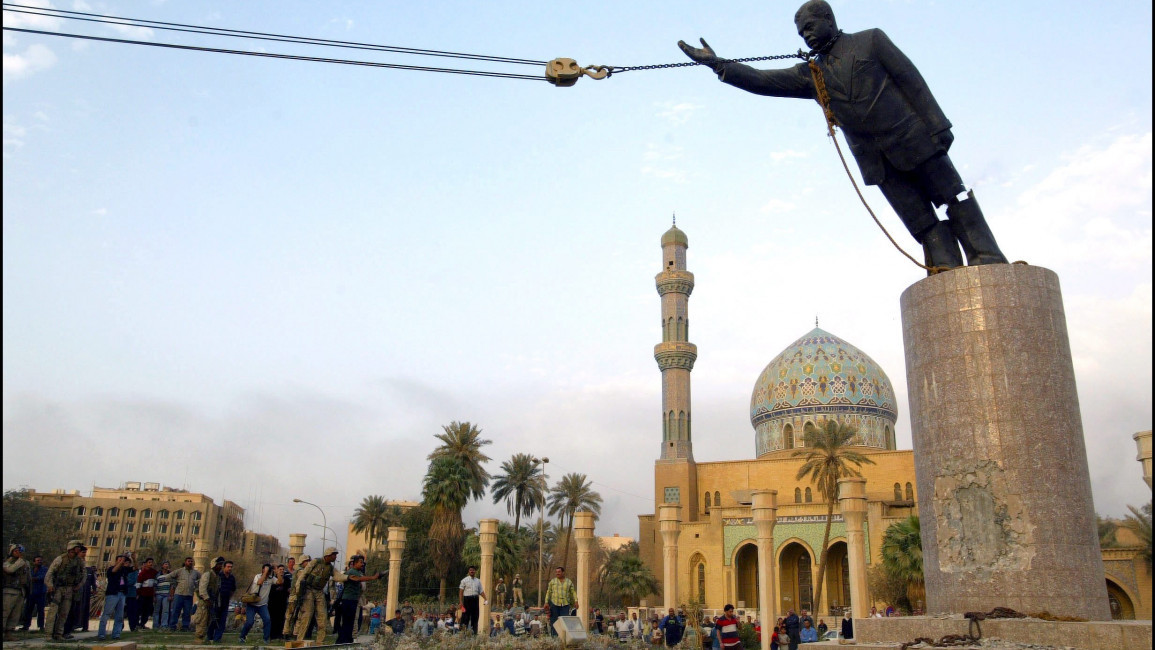Controversy explodes over Saddam Hussein statue in Iraqi Kurdistan's Sulaimaniyah
A statue of Saddam Hussein, the president of the former Iraqi regime, erected in Sulaimaniyah City in the Kurdistan region has sparked controversy, with several opponents viewing it as an insult to the former dictator's victims.
The statue was placed at the Red Security National Museum in Sulaymaniyah in commemoration of the 33rd anniversary of liberating Sulaimaniyah city from Hussein's ousted Baath regime on 7 March 1991. Soon after, the statue sparked controversy as many people raised their voices against the step. The issue soon became viral on social media platforms, compelling the Museum and Kurdish authorities in the city to finally remove the statue.
While critics perceive it as a disrespectful gesture towards the victims of the dictator, the museum management maintains that the presence of the statue symbolizes "the downfall of tyranny."
The statue was carved in 1997 near Arafat Square in Kirkuk, then it was removed during the 2003 war, and it was returned to Sulaymaniyah by Kurdish photographer Fayeq Hamah Saleh who presented it as a gift to the museum dedicated to the victims of the former regime.
"When I saw the statue of Hussein being erected inside the museum with marbles around it, I considered that as an insult to the thousands of Kurdish victims of the former dictator. I expressed my rejection on the issue, and soon it became viral, and most relatives of the martyrs supported my view," Nawroz Mangr, a Kurdish activist from Sulaimaniyah, told The New Arab. He clarified that eventually, Kurdish officials removed the statue, noting there are plans for the statue to be erected again in a more proper way at the Monument of Anfal victims in Chamchamal town.
TNA contacted Hamah Saleh, but he was not immediately available to comment.
There were allegations by Kurdish social media users and some outlets that the statute had been removed as per pressures from Iran, however, the Kurdish activist dismissed those allegations.
He also said Fayeq Hamah Saleh who has documented the 1991 Kurdish uprising against the former Sadame regime, is his close friend and his intention for putting the statue was "not malicious", but the statue had been erected in the "wrong way".
TNA contacted Ako Gharib, the director of the museum, but his son said that he was on leave due to illness.
According to videos published online, the entire design works to enlarge and glorify Saddam Hussein in front of the viewers.
The idea of placing Saddam's statue in the museum was to commemorate the fall of the dictator who caused tragedies for the Iraqi people and committed tens of genocide against them.
The Red Security served as the headquarters of the northern division of Iraq's secret intelligence agency that utilised this facility for the torture and imprisonment of Iraq's Kurdish population. After 1991, it was untouched and turned into a national museum where piles of Saddam's heavy tanks and cannons were also kept for viewers.
In 1987 and 1988, as the Iraq-Iran war was winding down, Saddam Hussein's regime launched a massive military campaign in Anfal against Kurdish villagers who were supportive of the various Kurdish peshmerga rebels. Consequently, between 50,000 and almost 200,000 people were killed, including women, children and the elderly, many of whom were buried in mass graves across the southern deserts of Iraq.
On 16 March 1988, Saddam's regime attacked the people of Halabja city, killing more than five thousand people, and wounding tens of thousands. Saddam's regime was toppled following the 2003 US-led invasion of Iraq, and Hussein was captured in December 2003. He was hanged three years later following his conviction for 'crimes against humanity', including the Halabja massacre.


![Minnesota Tim Walz is working to court Muslim voters. [Getty]](/sites/default/files/styles/image_684x385/public/2169747529.jpeg?h=a5f2f23a&itok=b63Wif2V)




![Debris near Rafic Hariri International Airport [Getty]](/sites/default/files/styles/image_212x120/public/2176162423.jpeg?h=a5f2f23a&itok=XLiO6WHk)
![An Israeli air strike on Jabalia killed teenage journalist Hassan Hamad [Screengrab/X]](/sites/default/files/styles/image_212x120/public/2024-10/hassan%20hamad1.jpg?h=c12e0b96&itok=KstD_5xk)
